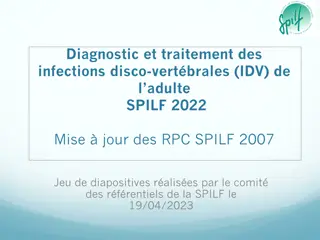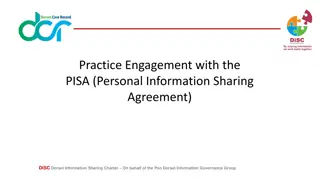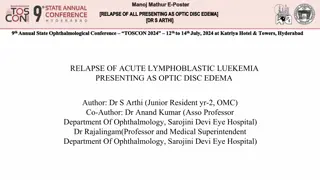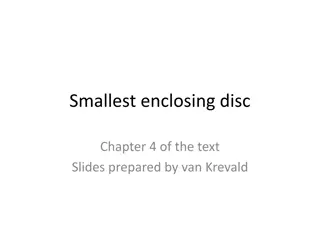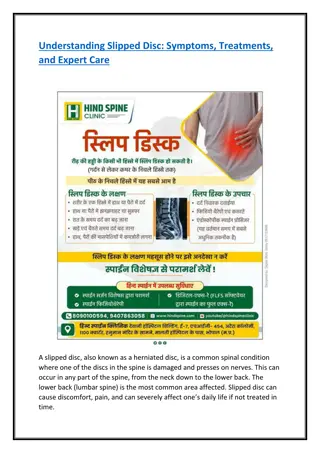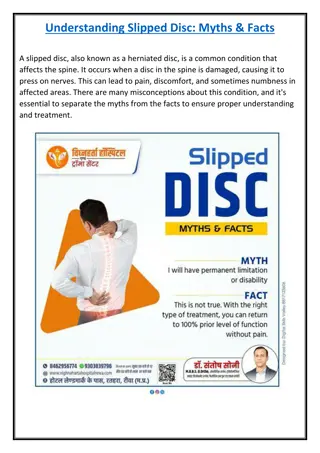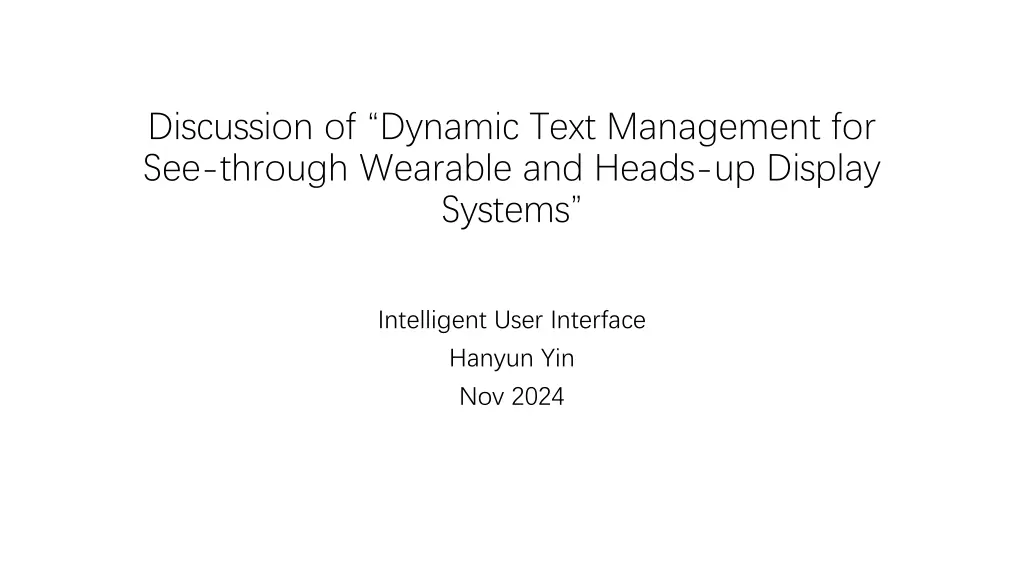
Cutting-edge Research on Dynamic Text Management in Wearable AR and HUD Systems
Explore the cutting-edge research on dynamic text management in see-through wearables and heads-up display systems. This research focuses on user-centric design, integrating machine learning algorithms, and the relevance of human factors in advancing AR and HUD technologies. Drawing insights from Simon's and Suchman's theoretical perspectives, the paper emphasizes adaptive text placement for enhanced readability and cognitive efficiency. Stay updated on the latest advancements in technology and user interface design!
Download Presentation

Please find below an Image/Link to download the presentation.
The content on the website is provided AS IS for your information and personal use only. It may not be sold, licensed, or shared on other websites without obtaining consent from the author. If you encounter any issues during the download, it is possible that the publisher has removed the file from their server.
You are allowed to download the files provided on this website for personal or commercial use, subject to the condition that they are used lawfully. All files are the property of their respective owners.
The content on the website is provided AS IS for your information and personal use only. It may not be sold, licensed, or shared on other websites without obtaining consent from the author.
E N D
Presentation Transcript
Discussion of Dynamic Text Management for See-through Wearable and Heads-up Display Systems Intelligent User Interface Hanyun Yin Nov 2024
relevance of research today Technological Advancements: Technological Advancements: The paper's focus on dynamic text management has paved the way for modern innovations in AR and HUD systems. Current research continues to build on these concepts by integrating machine learning algorithms to optimize text placement based on user behavior and environmental context. Integration of Human Factors: Integration of Human Factors: The paper's emphasis on user-centric design has led to a deeper exploration of human-computer interaction (HCI) in AR systems. Current research examines how factors like comfort, ease of use, and perceptual accuracy influence user acceptance and performance. Edge Computing Edge Computing: Processing visual data directly on device enhances real-time performance.
Simons Theoretical Perspective One of Simon's key opinions is that human thought processes are adaptive and shaped by the human thought processes are adaptive and shaped by the environment. environment. This aligns with the paper's approach to dynamic text management, which adapts text placement based on real-time environmental factors to enhance readability and reduce cognitive load. The paper's use of real-time camera tracking to adjust text placement reflects Simon's view that systems should simplify user interactions while accommodating environmental complexities. systems should simplify user interactions while accommodating environmental complexities. Simon also discusses the importance of memory organization and efficient retrieval the importance of memory organization and efficient retrieval processes. processes. This is relevant to the paper's focus on dynamically managing text to ensure that information is accessible and not overwhelming. The paper's emphasis on adaptive text management aligns with Simon's principles by advocating for systems that intelligently filter and present information based on user context, thus enhancing cognitive efficiency.
Suchmans Theoretical Perspective The paper's focus on dynamic text management aligns with Suchman's emphasis on the need for systems to adapt to users' contexts. Suchman argues that effective human account for the complexity of real account for the complexity of real- -world situations, suggesting that systems should be designed to world situations, suggesting that systems should be designed to respond flexibly to user needs and environments. respond flexibly to user needs and environments. effective human- -machine interaction must machine interaction must The dynamic management of text implies a recognition of users as active participants who shape their interactions with technology, rather than passive recipients of information. This reflects Suchman's view that users bring their own interpretations and intentions into their interactions with machines. users bring their own interpretations and intentions into their interactions with machines. While the paper advocates for automated text management systems that operate independently, Suchman would likely caution against over over- -reliance on automation reliance on automation. She emphasizes that machines should support human decision-making rather than replace it, arguing for a balance where technology enhances rather than dictates user actions.
How our project can learn from this paper Our project is the resume generation project. Real Real- -Time Context Awareness Time Context Awareness: Utilizing technologies enables system to understand the user's environment and adjust accordingly. Intelligent UIs can benefit from similar context-aware capabilities, ensuring that information is presented in a way that is relevant and accessible at any moment. Input analysis and interpretation Natural Language Processing (NLP): Implement advanced NLP algorithms to interpret user input, such as job descriptions, industry keywords, and user profile, to generate content. Real-Time Data Parsing: Use fast and efficient parsers that can extract key information from documents or user input and provide immediate feedback or suggestions using AI.
How our project can learn from this paper Dynamic Adaptation Dynamic Adaptation: Intelligent UIs should dynamically respond to user context and preferences to enhance usability. Adaptative template Modular Resume Templates: Create resume templates that can dynamically adapt their structure based on the role (e.g., switching from a skills-focused layout to an experience-focused one for different job types). Customizable Content Blocks: Allow the system to complete different content sections based on the specific job description provided by the user.

